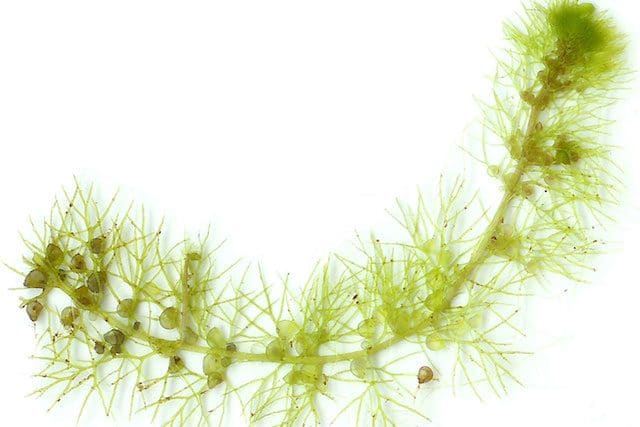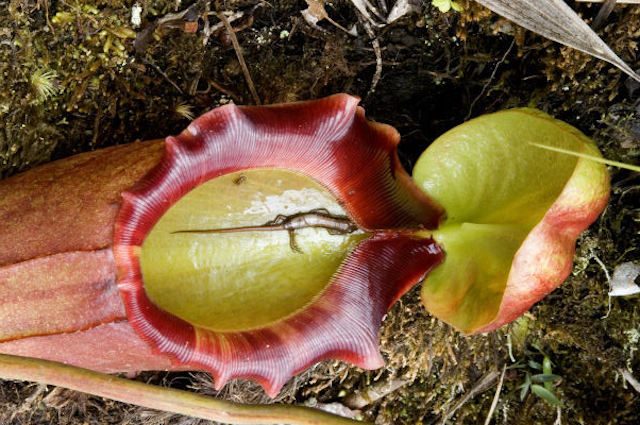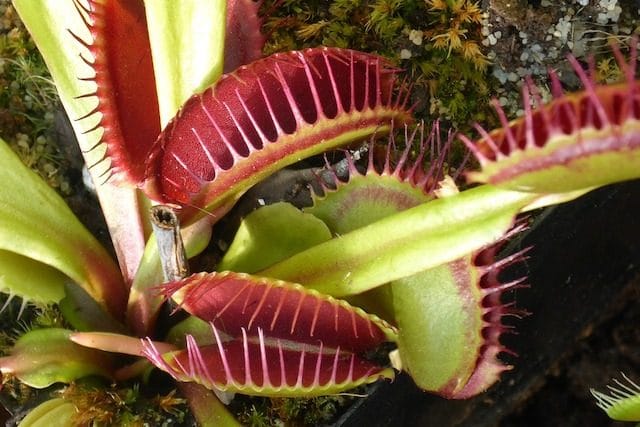Moving plants and carnivorous plants are a novel concept popularly portrayed in science fiction horror of the botanical genre. We all know Little Shop of Horrors. But in reality, motile, active plants are a real thing and go beyond the Venus Flytraps of bug-eating fame. While they certainly do not hunt humans, the reality of motile plants and carnivorous plants is worth discovering. In this list, we discover plants that are motile and carnivorous, simply carnivorous, or simply motile in some way. The phenomenon is known as Rapid Plant Movement, which could be abbreviated “RPM,” recalling measures of mechanical motor speed.
10. Bladderwort

Ponds may seem tranquil and filled with leisurely and strange water bugs going their different ways, but below the surface, minute networks of bladders lurk, connected to their plants and awaiting the chance to snap shut, capturing food coming into contact with the bladders. Insect eating or otherwise carnivorous plants are frequently associated with land based environments, but bladderwort lurks in aquatic zones where water is fairly stagnant but populated with ample minute prey. Insects, worms and other invertebrates may be eaten by these plants. Native to lakes, slow moving rivers, pools, and even waterlogged ground, bladderwort species are found digesting their prey around the globe.
Lacking any roots, the bladderwort plant relies upon the capture of live prey to provide essential nutrition to keep the plant alive, along with the benefits of some photosynthesis. Certain larger species, such as the Greater Bladderwort, may eat larger prey items than mere insects and micro-crustaceans. Vertebrate prey items including small fish fry and tadpoles may be consumed by large bladderwort species and turned into liquid nutrition. Bladderwort plants sport attractive flowers that protrude above the surface of the water, catching the eye of human admirers and pollinators alike while the feast goes on below.
9. Triggerplant

Pollination apparently takes work and effort to bring commensurate results. The trigger plants are almost entirely restricted to Australia, where they pollinate insects by selectively reacting to certain species and “choosily” opting to release their pollen in a trigger-like fashion on some insects and not on others. Upon landing on a trigger plant, the insect will be struck in what seems like a predatory assault, hit by a trigger mechanism.
But the trigger plants do not kill the unwary insect. Instead, the insect is being forcefullydusted with pollen through the strike. Once that action has been deftly completed, the insect will leave the flower, landing on another flower, seemingly unbothered. This next flower upon which the insect is preparing to land will be primed to receive pollen, completing the entire pollination cycle.
Interestingly, the plants are considered to be “semi-carnivorous” since there is evidence that in addition to being pollinated by insects dusted by their striking mechanism, sticking hairs positioned on the back of the flowers and below the blossoms also can lethally trap miniature insects. The trigger plants appear to be able to subsequently harvest and digest the carcasses of these little insects to a degree, gaining a measure of nutrients from the remains.
8. Tropical Pitcher Plants

Tropical pitcher plants do not exactly move around or wave and clap like some carnivorous plants, but their methodology of trapping is brilliant. Elongated stems contain pitchers with an enticing fluid that brings insects close to drink, then fall to their death and nourish the plant. Native to the old world tropical regions, the relatively huge pitcher plant species of the genus Nepenthes are far too small to be capable of the awful human devouring behavior of fiction depicted onscreen and in books by man eating plants, but they can engage in some shocking acts of plant on animal predation.
The fluid which fills up the plant’s namesake pitchers is not only attractive to passing prey but also highly viscous, resisting attempts by captured victims to escape. Incredibly, not only insects but rats may be eaten by a particularly large species known as Nepenthes rajah. While infrequent, entrapment and digestion of such mammalian “trespassers” occurs and provides a good dose of nutrition to the well adapted giant pitcher plants that trap them. Opportunistic drinking behavior by monkeys has been observed, where these cousins of humans “steal” from the plant by drinking their trap fluid then leaving, being much too large and powerful to be targeted by the plant.
7. Sensitive Plant
https://www.youtube.com/watch?v=o5gxmV-7GhI
Well named, the peculiar Sensitive Plant looks simple and ordinary, resembling a small fern, but moves like lightning, as far as a plant is concerned, folding its leaves upon being touched. Furthermore, the motion can be set off at any time with a simple human touch. The plant, also amusingly called a Shame Plant or Shy Plant is a native species of Central American and South American regions. The plant actually sweeps its multiple leaf fronds inward upon contact with humans. The dramatic and seemingly animal-like or otherwise biomechanical movement is clearly visible in a matter of seconds and recalls a folding Chinese fan.
The species is successful, having spread all around the globe in suitable climate zones. However, the exact purpose of the folding response to any kind of touch to the plant’s leaves remains a subject of speculation by botanists and plant fanciers alike. Possible reasons for the folding put forward include avoidance of predators or a way to avoid excessive losses of water in warm environments, which could potentially damage the delicate leaves. The plant typically grows under larger plants such as shrubs or trees, and while originating as a vertical stemmed plant, develops a trailing habit over time, sometimes reaching five feet in length.
6. Sundew
A frequently mentioned species among greenhouse enthusiasts, Sundew species are also among the worst for possible plants for hungry insects to encounter. Occurring on all the world’s landmasses save for Antarctica, Sundew are generally stubby-looking plants that deceptively attract insects, hold them fast, and then dissolve such prey in a digestive process all with the help of their numerous mucilaginous glands that extend from the plant in stalk form. Comprised of leaves and stems with club-like glands covered in fluid secreting tentacles, Sundew plants are eye-catching and perfectly adapted to catch insects that are drawn to the plant. The sweet compounds released by the tentacles not only appeals to insects but functions as a type of entrapping glue once sampled.
Furthermore, the all-purpose compound contains numerous enzymes that begin digestion of the prey once trapped. Due to the secretions of fluid from the well named plants worldwide sparkle in the light, Sundew plants sparkle brilliantly in the light, making them a top choice for enthusiasts, though they are notably hard to grow. A diverse group, sundews consist of an assortment of over 190 species. Interestingly, while many are herbaceous, elongated and thin climbing sundew species can extend as they grow. Drosera erythrogyne may even climb 10 feet.
5. Waterwheel Plant
Beneath the surface, little known carnivorous water plants are busy making their best effort as gatherers of aquatic prey, primarily small insects. Bladderworts are not the only category of plants engaged in this activity. The interestingly named Waterwheel Plant Aldrovanda vesiculosa boasts wheel-shaped leaf structures that extend from the central stem. Peculiar in appearance, the entirely aquatic plant is a voracious consumer of insects, crustaceans and other tiny aquatic animals that get close enough to be captured and consumed by the plant’s feeding apparatus. The global distribution of species includes parts of Africa, Europe, Asia and Australia.
The whorl-shaped leaves that together form a series of wheel-like structures hold traps with a cupping action at each leaf end within the wheel. Hair triggers, if touched, will set off the prey capture response. At any moment prey brushes against the hair triggers, the traps close at high speeds, going from open to shut in either a quarter or a half second. Interestingly, the aquatic adaptations of the plant might mask its surprising true identity. While resembling some types of pondweed at first glance, the masterfully adapted catcher of tiny water animals is actually a relative of the much better known and land based Venus Flytrap plants that hunt airborne and crawling insects.
4. Telegraph Plant
While many moving plants are well known, even notorious for drowning and devouring insects in vats of digestive fluid or slamming spiny trap doors shut prior to feeding on them, a simpler purpose for being a moving plant exists. A known curiosity, the Telegraph Plant Codariocalyx motorius which bears the name motorius in reference to its peculiar powers of movement is a deceptively ordinary looking plant that will certainly catch your eye when you watch it position itself. The purpose of this plant’s movement is to maximize its ability to harvest sunlight.
Native to the Asian tropics, the plant is known for moving its leaflets at sufficient speeds to be detected by the human eye. Standing upright with tall, straight stems, the green plant with purple flowers bears oval-shaped leaves with spindly attachments to the main stem. Like a living sundial, the leaves align themselves by tracking the movement of the sun as you watch. Also known as the dancing plant and semaphore plant, the telegraph plant is a species that was first described in the year 1880 by Charles Darwin himself. The environment in which this plant typically grows is rainforest, where this remarkably well adapted plant must compete with taller species for available sunlight.
3. Squirting Cucumber
https://www.youtube.com/watch?v=fyhiSL2MwTg
Cucumbers might not come to mind as the most “active” of plants, seemingly heavy and sedentary vines that produce massive edible fruits that are treated more like a vegetable. Yet, there is a type of cucumber that defies imagination and takes seed locomotion to a dramatic new level among cucumbers and other members of the squash family. The Ecballium genus plants, known as the Squirting Cucumbers, possess a remarkable means of spreading their kind. When ripe, Squirting Cucumbers, true to their name blast out a stream of fluid filled with seeds.
The fuzzy leaved plant achieves its results by producing grenade shaped fruits that launch seeds up to 20 feet away from the plant! Interestingly, squirting cucumbers, unlike the plethora of edible squash species are absolutely not to be eaten. Any piece or component of the plant may result in death if consumed by humans, being highly poisonous. The strange plants have a hairy and dark appearance, with a size of up to two feet, while the fruits may measure two inches in length. Squirting cucumbers are native to dry habitats in the Mediterranean region. As a result of their exceptional means of seed spreading, squirting cucumbers have gained considerable interest as a curiosity of among some fanciers as extraordinary horticultural novelties.
2. Venus Flytrap

The Venus Flytrap may be incredibly famous for good reason, but this species, that is on the surface familiar, actually deserves deeper coverage than it usually gets on this list of moving plants. Interestingly, a combination of sticky fluid and tooth-like structures that hold in prey between the “clamshells” once captured add to the appearance of this species, which stands out as remarkably animal-like in its “jawed” capture of prey. Not only insects, but even small frogs may be caught and consumed. Native to North and South Carolina wetlands, the Venus Flytrap was flagged by Charles Darwin as a plant species that was “one of the most wonderful in the world.”
Venus Flytrap plants can grow up to five inches in height, while each individual trap on the plant is lined with spiky “teeth” that act as bars imprisoning an insect caught when the trap is triggered. Once caught, the insect is digested by juices and nutrients are extracted. Then, the trap opens again and inedible parts spill out, leaving the trap ready to capture a new meal for the plant. Fascinatingly, the Venus Flytrap is “smart,” being “programmed” to “count” taps from an insect before committing to a capture, preventing debris from being trapped and an ill-fated digestion attempt being made. 1 tap puts the plant on alert; two shuts the trap, while three more taps will initiate the digestion sequence.
1. Witch Hazel

Witch Hazel may be familiar as a medicinal herb, but like the Sandbox Tree we’ve talked about before, the plant shoots its seeds to distances of up over 30 feet. You certainly wouldn’t want a Witch Hazel seed in the eye! Four species of Witch Hazel plant occur in North America, while China is home to a single species with one species also found in Japan. Used for external medicinal applications, the plant is a seemingly ordinary looking shrub typically growing low and being located in the forest understory layer, though heights of 30 feet may be attained by some specimens.
An exceptionally late bloomer, Witch Hazel is commonly the final shrub to produce blossoms in North America. The seeds take an incredibly long time to reach maturity, that is, one year. As a result, seeds from the prior year are often juxtaposed with blossoms from the current year. When the seeds are ready, the stored up kinetic energy they hold is released in violent and spectacularly effective seed pod bursts. Maximizing the spatial distribution of witch hazel seedlings, seeds from exploding pods are spread around in a bb gun fashion before sprouting into new shrubs.